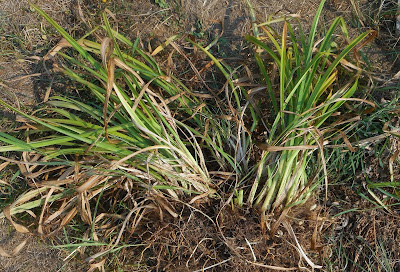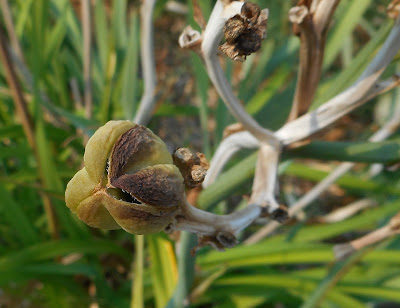 |
| NOID Daylily before division. 8.23.15 |
 |
| Out of the ground. There are 2 main clumps. 8.23.15 |
Today I divided my oldest daylily cluster. Last year I moved this bunch from the old Vancouver yard to the Battleground yard. I was anxious to get it intothe ground, so did not divide it. There was grass growing deep into the cluster, which has been difficult to pull out.
It needed dividing. There were only 2 flower scapes this year. In the past, it had many. It has been done blooming for a few weeks.
I wanted it to be in a more prominent location. I am limited on good spots, so part of it went back into the original location, but with fresh garden soil.
Digging it up, two main sub-clumps were apparent. I used shovel to slice through. Some gardeners use 2 garden forks and pry them apart. That results in less root loss. I don't think that will be a problem. I don't have 2 garden forks.
Two smaller divisions fell off when I split the big clumps. So I have 2 good size, and 2 starter size clumps.
They are replanted, mulched, and watered. One of the small ones is in container for TLC and maybe gift.
The Stella de'Oro was divided, I think, in Mid July. Both halves regenerated new leaves and bloomed. Very nice, and one of only three daylilies now blooming. Happy Returns is also blooming.
The other was labeled as the variety "Frans Hals". It looks semi-similar to the photo. Either a mutant, possibly due to improper tissue culture technique, or a seedling. I liked this photo with a bug in the nectar pocket. I cross pollinated the "not quite Frans Hals" with both Stella and Happy, both as pollen donor and recipient.
 |
| Split using shovel and hand action. 8.23.15 |
 |
| One of the replanted clumps. 8.23.15 |
 |
| Stella de'Oro divided in July. 8.23.15 |
 |
| Daylily labeled as "Frans Hals". 8.23.15 |
 |
| Daylily Seedpod. Pod Parent Chicago Apache. 8.23.15 |
The first of the Chicago Apache seedpods started to split, so I picked it. The stem is brown and dry, so the seeds will obtain no more nutrition from the plant. The seeds are black and shiny, so I think they are fully ripe.
Pollen parent is either Chicago Apache or Fooled Me. Doesn't matter, I'm not a commercial grower, and won't be.
These went into a wet paper towel / plastic zipper bag / refrigerator, for stratifying.
I wondered what I would do with all of the seeds from the hybridizing efforts. This pod made only 4 seeds, so maybe I won't have too many.
I don't need a lot. I just kept dobbing pollen to pistils to see what happened.
 |
| Daylily Seeds. Pod Parent Chicago Apache. 8.23.15 |